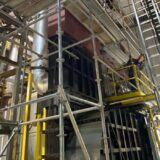What Safety Measures Are Critical in Industrial Construction?
Ensuring safety in industrial construction is paramount. With numerous hazards around, understanding the essential safety measures can save lives and prevent accidents. In this FAQ guide, we’ll break down the critical safety measures that every industrial construction site should prioritize.
Why is Safety Training Important?
Safety training educates workers about potential hazards, safe practices, and how to react in emergencies. Regular training ensures everyone is up-to-date with the latest safety protocols.
Beyond preventing accidents, safety training fosters a culture of awareness and caution among workers. A well-informed team is less likely to take dangerous shortcuts or ignore warning signs. This consistent education helps in reinforcing the importance of compliance and adherence to safety norms. Workers feel more confident and less stressed when they know the correct procedures.
Moreover, training sessions can be tailored to address the unique challenges of each construction site. Specific hazards can vary greatly depending on the project’s environment. By customizing the training material, you ensure that workers are prepared for particular scenarios they might face day-to-day. This level of preparation makes a significant difference when dealing with emergencies.
How to Ensure Proper Use of Equipment?
Proper use of equipment reduces the risk of accidents. Ensure that all machinery and tools are in good condition, and workers are trained in their use before operation.
Regular maintenance checks are key in preventing equipment failures. A well-maintained machine is less likely to malfunction, which in turn reduces the risk of injury. Keep detailed records of all maintenance activities and ensure that any issues are addressed promptly. This routine not only ensures higher productivity but also makes the work environment safer for everyone involved.
Another crucial aspect is the correct usage of personal protective gear while operating machinery. Even if the equipment is in perfect condition, improper interaction can lead to serious injuries. Training programs should emphasize the importance of using guards, restraints, and other safety devices. Additionally, clear operating instructions should be posted at every station to serve as constant reminders for workers.
What Personal Protective Equipment (PPE) is Necessary?
Personal Protective Equipment (PPE) is essential for safeguarding workers. Helmets, gloves, safety glasses, and steel-toed boots are some of the basics. Always assess the specific requirements of your site.
It’s important to conduct a thorough risk assessment to determine the specific PPE needed for different tasks. For instance, electricians might require insulated gloves, whereas welders would need face shields and fire-resistant clothing. Tailoring PPE to the specific needs of the job not only ensures better protection but also encourages compliance among workers since the gear is more relevant to their tasks.
How Often Should Site Inspections Be Conducted?
Regular site inspections help identify and mitigate potential hazards. Conduct inspections daily or weekly, depending on the size and complexity of the project, and address any issues immediately.
These inspections should cover all areas of the construction site, including workspaces, machinery, and safety equipment. Checklists can be useful tools for ensuring that no critical aspect is overlooked. Having multiple sets of eyes on potential problem areas can uncover issues that might be missed during routine operations. Additionally, involving team members in the inspection process can empower them and increase overall site vigilance.
What Are Effective Emergency Preparedness Plans?
Effective emergency plans include clear evacuation routes, first aid stations, and communication protocols. Regularly drill emergency procedures to ensure all workers know their roles in a crisis.
Having clearly marked and easily accessible evacuation routes is critical. These routes should be free of obstructions and well-lit to facilitate quick and safe exits. It’s also vital that first aid stations are fully stocked and that personnel are trained in basic first aid practices. This preparedness can make all the difference in stabilizing an injured worker until professional medical help arrives.
Emergency plans should also include designated roles for certain workers. For instance, fire wardens or first responders who have additional training to manage the initial few minutes of an emergency until help arrives. This level of organization helps prevent chaos and ensures a more efficient response.
How to Promote a Culture of Safety?
Promoting a safety culture involves everyone, from management to workers. Encourage reporting hazards, reward safe behavior, and lead by example to foster a workplace where safety is a priority.
Creating an open environment where workers feel comfortable reporting hazards without fear of retribution is essential. Management should actively solicit feedback and take visible actions to address concerns. This consistent, transparent approach builds trust and underscores the importance placed on safety.
Additionally, recognizing and rewarding safe behavior can go a long way in promoting a culture of safety. Whether it’s through bonuses, awards, or simple acknowledgements, recognizing efforts helps reinforce positive behavior and motivates others to follow suit. This approach not only improves safety but also boosts morale.
Finally, leading by example is one of the most effective ways to cultivate a safety-first mindset. When management consistently follows safety protocols and demonstrates a commitment to creating a safe work environment, it sets a standard for the entire team. This top-down approach ensures that safety becomes an integral part of the workplace culture.
Wrapping Up Industrial Construction Safety Measures
In summary, industrial construction safety measures are vital for protecting workers and ensuring successful project completion. By adhering to regular safety training, proper equipment usage, personal protective gear, site inspections, and emergency planning, you can create a safer work environment. Stay informed and prioritize safety at all times.



